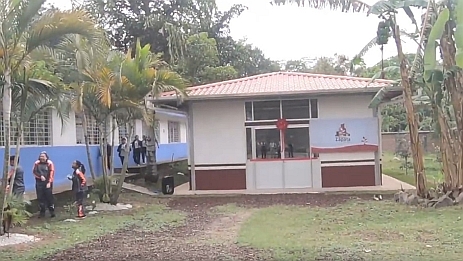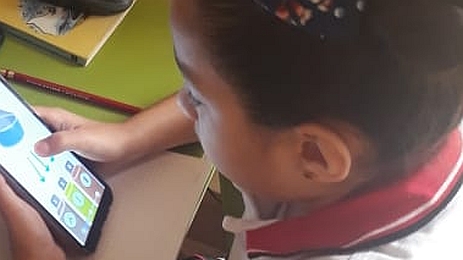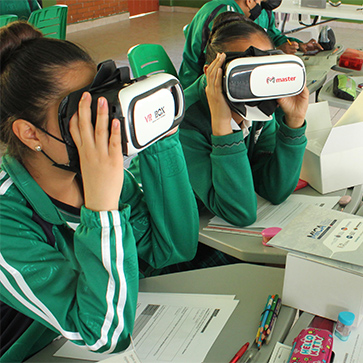The joy of seeing children grow and succeed
Irene del Carmen Santos Cruz teaches in a suburb of Xalapa City, the capital of the Mexican state of Veracruz. Her students come from families without a steady income, and the social inequality became espeically noticeable during the pandemic: fourteen of her 26 schoolchildren did not have a digital device to access online lessons. But Irene del Carmen Santos Cruz did everything she could to ensure her class would learn and not be left behind due to a lack of connectivity.
»I realized that I needed to give the children more freedom to discover and explore things on their own.«
Irene del Carmen Santos Cruz, teacher at Telesecundaria Adalberto Tejeda
in La Estanzuela, Mexiko

The COVID 19 pandemic has made the need for digital teaching and learning materials in school lessons undeniable. Figures from UNESCO indicate that some 160 million students in Latin America alone were impacted by school closures. In response to the need for urgent action, Siemens Stiftung joined forces with partner institutions and education ministries in Latin America to launch the STEM Education for Innovation initiative. With financial support from Siemens Caring Hands e. V., the initiative enabled access to innovative educational formats for STEM classes in seven countries. A series of interviews with educators provides a glimpse of how everyday life has changed in kindergartens and schools.
STEM Education for Innovation
Learn about the 14 projects in the Latin American STEM education initiative.
From the very beginning, Irene del Carmen Santos Cruz has been committed to continuing education for children from socially disadvantaged families. Instead, she communicated with her students and their parents using landline telephones and via email. She even created daily PDFs of lessons to ensure her class would learn and not be left behind due to a lack of connectivity. Siemens Stiftung and INNOVEC (Innovación en la Enseñanza de la Ciencia) webinars from the STEM Education for Innovation education initiative were a useful content resource for Irene, who used the free materials on the OER platform CREA (Centro de Recursos Educativos Abiertos) in her lessons. But the initiative also brought about permanent change to the way she teaches.
Background
I teach at a school called Telesecundaria Adalbert Tejeda. A ‘telesecundaria’ is a unique school form that was created in 1968. It broadcasted lessons over television to bridge the gap between rural and urban schooling situations. Today, this school system refers to a situation where there is only one teacher per class who teaches all lessons and is with the students the whole day.
The school is in La Estanzuela, a small communitiy near the capital of Veracruz state, Xalapa City. Even though the town is just a few minutes from the capital, the socio-economic backgrounds of the familites who live here are not the best.
My 26 students are between 13 and 14 years old. Prior to the pandemic, I worked with them from 8 in the morning until 2 in the afternoon. Ideally, I would teach six subjects per day, but that wasn’t always possible. I prefer to spend as much time as is needed addressing each subject. I teach with a textbook and video – that’s how telesecundarias are currently set up.

The COVID-19 pandemic
At the very beginning of the pandemic, I asked my students to record their work and activities in a notebook and to hand them in on Mondays and Tuesdays so I could check them. One person from the community joined me on the journey to collect the notebooks each week. It wasn’t easy. At home, the pile of documents that I needed to check kept growing. But I was at least able to make it to the end of the second semester – March to June 2020 – using this method.
I asked the parents to create an email account so they could remain in contact with me.
After that, I asked the parents to create an email account so they could remain in contact with me. I also asked each family to have a mobile phone so I could stay in touch with them all using WhatsApp. I wanted to send them homework assignments each day.
I opened a Zoom account. At the beginning, I was quite optimistic that this would be the perfect solution for reaching my students. I even bought a board that I could write on and use as my background. But I soon found out that it just wasn’t possible to teach in this way.
Unfortunately, there was a fundamental problem: the children’s families are relatively poor, and many parents don’t have regular work. When the coronavirus hit last year, I conducted a survey and found out that only two of my students had a computer. The rest had to use a mobile phone to participate in the lessons, and in many cases, they had to share that device with other members of their family.
But even that didn’t solve the problem because they only had a limited amount of data available. Not everyone has access to the internet at home, either, which meant some could only listen to the audio and couldn’t watch the video to save data. This made it all quite difficult. The pandemic opened our eyes to the widespread existence and broad scope of the inequalities in our community. It’s a huge challenge.
The pandemic opened our eyes to the widespread existence and broad scope of the inequalities in our community.
Of my 26 students, only 12 managed to get an internet connection. With the rest, I tried to reach parents via landline telephone and tell them to encourage the children to do schoolwork at home.
I understand how tiresome it must be for students to learn in such a precarious financial situation.
One of my students is called Giovanni. When I spoke with his parents, the mother said: ‘Ms. Teacher, my husband lost his job last month. I’m the only person in our house who is earning money. It’s hard for us to keep up with everything.’ I understand how tiresome it must be for students to learn in such a precarious financial situation. Despite these hurdles, Giovanni made progress. I was able to motivate him over the phone. I stayed in touch and asked him to complete tasks on his own. Giovanni ended the school year in great shape, which makes me proud.
Another student, Irene, couldn’t stay connected to the lesson for the entire duration. Instead, I send her an email every day with a PDF of the material that we had covered. Irene copied the entire content of each PDF into her notebook. That’s how she learned. She did her best with the few options that were available to her.
Most of my students follow along in the lessons on the screens of mobile phones. But the image they were looking at was too small. I began writing formulas and concepts on pieces of paper and then simply holding them close to the camera. Small, simple learnings like that really make a big difference.

Challenges for teachers and helpful training seminars
The most difficult part for me was dealing with the technology. I knew about Zoom, but I had never used it. Not only did I need to learn it myself, but I also needed to teach parents how to use it and to help their children work with it.
Shortly before the pandemic, I took a certificate course on the use of technology in education. When the pandemic began, I repeated the course online to build upon my abilities.
From mid-April until mid-June, I took part in a course called ‘Introducing the STEM approach and its relevance for sustainable social development.’ It’s a webinar conducted by Siemens Stiftung and INNOVEC. That’s where I heard about CREA for the first time. It’s a very interesting platform that offers a wide range of resources for STEM lessons – accessible with the click of a button. CREA also provides valuable input on how to establish more innovative lessons. I use the materials in the lessons to motivate the children – that was an innovation for me, too.
Centro Recursos Educativos Abiertos
CREA gathers a wide range of didactic materials for STEM education.
I considered how to conduct my lessons.
Martín Bascopé, head of the Education for Sustainable Development department at Pontificia Universidad Católica (PUC) in Villarrica, Chile, introduced us to the methods of inquiry-based learning in the webinar. These can be paired with various strategies to improve learning for students. I was really impressed.
I learned that in my lessons, I tended to use a ‘managed experimental approach.’ I realized that I needed to give the children more freedom to discover and explore things on their own. I needed to become more open, which led to some careful consideration about how I conduct my lessons . In the webinars, I also learned how I can adapt the experiments for curricular content that’s already in the lesson plan.
Projects and future lessons
I am currently taking part in a project called an “ethnobiological garden,” which is part of an initiative from the Institute for Ecology. The goal is to reintroduce traditional knowledge from the community for using plants in different ways, improve their cultivation, and protect pollinating plants.
I’ve been working on a pollination garden with my class – it has flowers that attract a lot of bees, which go on to pollinate other plants. Working in groups, the students researched which plants were best suited for such a garden, where they should be planted, how much they should be watered, and what insects they would attract. Then I asked them to present their results. They used a lot of different tools and platforms for their research – that really took me by surprise. I didn’t expect that they would know how PowerPoint or similar programs work.

I’ve been working on a pollination garden with my class – it has flowers that attract a lot of bees, which go on to pollinate other plants. Working in groups, the students researched which plants were best suited for such a garden, where they should be planted, how much they should be watered, and what insects they would attract. Then I asked them to present their results. They used a lot of different tools and platforms for their research – that really took me by surprise. I didn’t expect that they would know how PowerPoint or similar programs work.
It’s all teamwork. I only recently became familiar with the resources and materials in CREA and am now beginning to put them to use in my lessons.
They used a lot of different tools and platforms for their research – that really took me by surprise.
I'm already planning to use materials from the CREA platform that I learned about in the webinar.
It’s all teamwork. I only recently became familiar with the resources and materials in CREA and am now beginning to put them to use in my lessons. For the next school year, I’m going to have the same students that I had this year, especially in chemistry. I’m already planning to use materials from the CREA platform that I learned about in the webinar: content on chemical reactions and how these play a role in cellular respiration and climate change.
CREA is such an open and easily-available resource that I’m also thinking about using it for math, physics, and biology lessons. It’s a really useful tool, and it’s free! For that reason, I see it as my responsibility to use the things I learn there and to pass them on to my class.
I always tell my students: At your age, if you can use technology, you can do anything you want: have a career, pursue a bachelor’s or master’s degree, or even go for a PhD. Education means the world is yours.
Education means the world is yours.
September 2021
STEM Education for Innovation
Together with partners in Argentina, Brazil, Chile, Colombia, Ecuador, Mexico, and Peru, we adapt STEM teaching and learning content for digital use in the classroom. The initiative is supported by Siemens Caring Hands e.V. and the German Federal Foreign Office.



